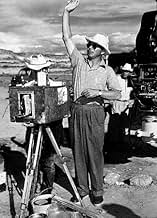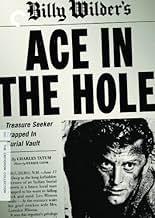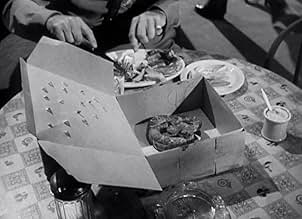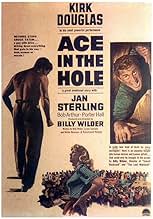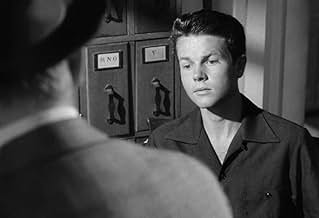Frustrated former journalist Chuck Tatum now working for an Albuquerque newspaper exploits a story about trading post owner Leo Minosa trapped in a cave to rekindle Chuck's career, but the s... Read allFrustrated former journalist Chuck Tatum now working for an Albuquerque newspaper exploits a story about trading post owner Leo Minosa trapped in a cave to rekindle Chuck's career, but the story soon escalates into a media circus.Frustrated former journalist Chuck Tatum now working for an Albuquerque newspaper exploits a story about trading post owner Leo Minosa trapped in a cave to rekindle Chuck's career, but the story soon escalates into a media circus.
- Nominated for 1 Oscar
- 5 wins & 3 nominations total
Robert Arthur
- Herbie Cook
- (as Bob Arthur)
Roy Regnier
- Nagel - New York Editor (replaced by Richard Gaines)
- (scenes deleted)
Oscar Belinda
- Barker
- (uncredited)
Storyline
Did you know
- TriviaAfter the film was released, it got bad reviews and lost money. The studio, without Billy Wilder's permission, changed the title to "The Big Carnival" to increase the box office take of the film. It didn't work. On top of that, Wilder's next picture, Stalag 17 (1953), was a hit and he expected a share of the picture's profits. Paramount's accountants told him that since this picture lost money, the money it lost would be subtracted from the profits of "Stalag 17".
- GoofsWhen Lorraine and Chuck are talking out in front of Minosa's store by the gas pumps, reflections of the crew moving around behind the camera can be seen in the store windows.
- Quotes
Charles Tatum: Bad news sells best. Cause good news is no news.
- SoundtracksThe Hut-Sut Song
(uncredited)
Written by Leo Killion, Ted McMichael and Jack Owens
Sung by Richard Benedict and Kirk Douglas
Featured review
The movie very closely parallels the real events of January 30 to February 16, 1925 in terms of the general story line. There are some significant differences concerning the actions of the characters.
Floyd Collins, a cave explorer working alone (not a real good idea), was trapped in Sand Cave KY, near Mammoth Cave. He was not looking for treasure, but for a new cave suitable for commercializing to produce income in an economically depressed region...and this was before the Depression occurred.
He became trapped on the way out of the cave by a 27 lb. rock which rolled onto his leg in a narrow crawlway. The configuration was such that it could not be moved enough to get his foot past.
When he failed to return home, the family went searching and quickly found him only 150' inside the cave.
A huge rescue effort was mounted and a cub reporter, Skeets Miller, from Louisville KY showed up to cover the story. It became one of the three most widely broadcast events of the time. Besides the extensive newspaper coverage, the relatively new medium of commercial radio riveted listeners with hourly accounts. It quickly became the first media circus ever seen.
Because of the print and radio coverage people began flocking to the site. A carnival atmosphere did indeed spring up around the cave. The state police and National Guard were called out by the governor to control the chaos and the more than 20,000 onlookers. The similarity between the real event and the movie on this account are likely nearly identical.
As in the movie, a decision was made to drill a shaft and, also as in the movie, the rock was fairly unstable and prone to collapse from the pounding of the cable tool drilling rig. The longer the effort went on, the more unstable the cave passage became.
Unlike Kirk Douglas' character in the movie, Skeets Miller served a most honorable role. Due to his small build he became one of very few persons able, and eventually the only one willing, to enter in an attempt to deliver food and water to Collins. He received a Pulitzer Prize for his reporting. Also unlike the movie, there was no manipulation of the event to delay the rescue, but there was considerable disagreement over how to best do it. Area coal miners made the initial attempts and the event concluded with the above-mentioned shaft.
Collins was presumed to have died 3 days before rescuers reached him. Because the conditions were so unstable, the body was left in the cave. The family was able to remove him about 80 days afterward for a proper burial. Later, his glass-topped casket was returned to the now-commercial cave as a tourist attraction. It was removed once again, and finally, in 1989.
In 1982, a definitive account of the event was published in the book 'Trapped!'. A most informative read.
In a take-off of the 'Free Tibet' bumper stickers, vehicles are occasionally seen with a 'Free Floyd Collins' sticker.
Floyd Collins, a cave explorer working alone (not a real good idea), was trapped in Sand Cave KY, near Mammoth Cave. He was not looking for treasure, but for a new cave suitable for commercializing to produce income in an economically depressed region...and this was before the Depression occurred.
He became trapped on the way out of the cave by a 27 lb. rock which rolled onto his leg in a narrow crawlway. The configuration was such that it could not be moved enough to get his foot past.
When he failed to return home, the family went searching and quickly found him only 150' inside the cave.
A huge rescue effort was mounted and a cub reporter, Skeets Miller, from Louisville KY showed up to cover the story. It became one of the three most widely broadcast events of the time. Besides the extensive newspaper coverage, the relatively new medium of commercial radio riveted listeners with hourly accounts. It quickly became the first media circus ever seen.
Because of the print and radio coverage people began flocking to the site. A carnival atmosphere did indeed spring up around the cave. The state police and National Guard were called out by the governor to control the chaos and the more than 20,000 onlookers. The similarity between the real event and the movie on this account are likely nearly identical.
As in the movie, a decision was made to drill a shaft and, also as in the movie, the rock was fairly unstable and prone to collapse from the pounding of the cable tool drilling rig. The longer the effort went on, the more unstable the cave passage became.
Unlike Kirk Douglas' character in the movie, Skeets Miller served a most honorable role. Due to his small build he became one of very few persons able, and eventually the only one willing, to enter in an attempt to deliver food and water to Collins. He received a Pulitzer Prize for his reporting. Also unlike the movie, there was no manipulation of the event to delay the rescue, but there was considerable disagreement over how to best do it. Area coal miners made the initial attempts and the event concluded with the above-mentioned shaft.
Collins was presumed to have died 3 days before rescuers reached him. Because the conditions were so unstable, the body was left in the cave. The family was able to remove him about 80 days afterward for a proper burial. Later, his glass-topped casket was returned to the now-commercial cave as a tourist attraction. It was removed once again, and finally, in 1989.
In 1982, a definitive account of the event was published in the book 'Trapped!'. A most informative read.
In a take-off of the 'Free Tibet' bumper stickers, vehicles are occasionally seen with a 'Free Floyd Collins' sticker.
Details
- Release date
- Country of origin
- Languages
- Also known as
- The Big Carnival
- Filming locations
- Laguna Pueblo, New Mexico, USA(church exteriors)
- Production company
- See more company credits at IMDbPro
Box office
- Budget
- $1,800,000 (estimated)
- Gross worldwide
- $2,300,000
- Runtime1 hour 51 minutes
- Color
- Aspect ratio
- 1.37 : 1
Contribute to this page
Suggest an edit or add missing content



